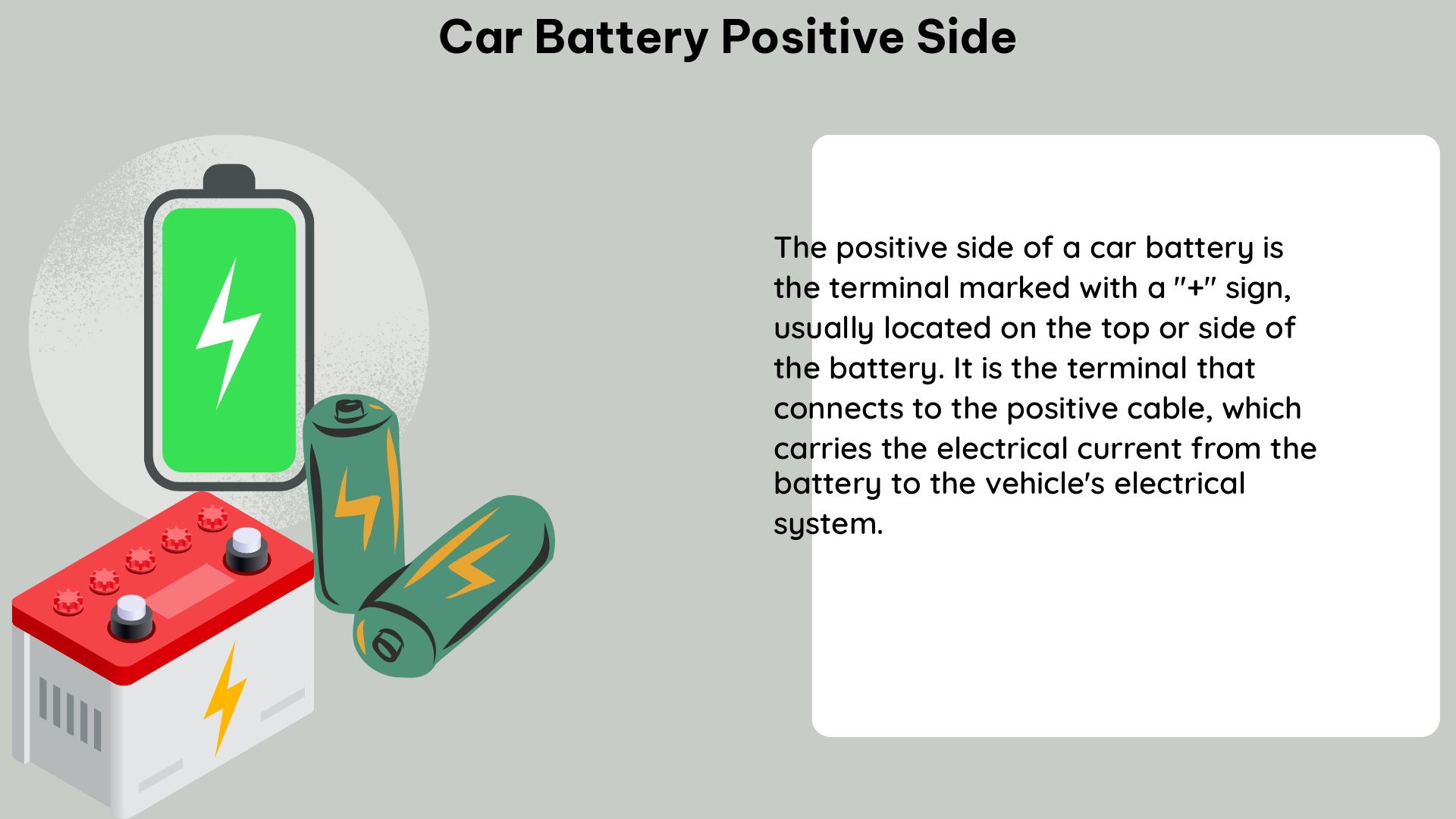The positive side of a car battery is a crucial component that plays a vital role in the proper functioning of a vehicle’s electrical system. Accurately identifying and properly handling the positive terminal is essential to ensure the safety and longevity of your car’s battery and electrical components.
Identifying the Positive Terminal
The positive side of a car battery is typically identified by a red protective cover or a black cover featuring a red plus (+) sign. Additionally, most batteries have a plus (+) and minus (-) sign stamped into the case, with the plus sign indicating the positive battery terminal. The positive cable is usually red, but this is not always the case, so it is essential to look for the plus sign on the battery case.
The positive terminal on a car battery is typically larger in size compared to the negative terminal, with a diameter ranging from 0.5 to 0.75 inches (12.7 to 19.05 mm). This larger size helps to accommodate the higher current flow required for starting the engine and powering the vehicle’s electrical systems.
To further distinguish the positive terminal, it is often coated with a thin layer of conductive material, such as copper or brass, to enhance conductivity and prevent corrosion. This coating can also help to identify the positive terminal, as it may have a slightly different color or sheen compared to the rest of the battery case.
Handling the Positive Terminal

When working with a car battery, it is crucial to exercise caution when handling the positive terminal. The positive terminal carries a high electrical charge and can pose a serious risk of injury or damage if not handled properly.
Proper Connection Procedure
To connect the positive cable to the battery, follow these steps:
- Ensure that the vehicle’s ignition is turned off and the parking brake is engaged.
- Locate the positive terminal, which is typically marked with a “+” sign.
- Carefully clean the positive terminal and the corresponding cable connector using a wire brush or sandpaper to remove any corrosion or buildup.
- Connect the positive cable to the positive terminal, making sure the connection is secure and tight.
- Avoid allowing the positive cable to come into contact with any metal parts of the vehicle, as this can cause a short circuit.
Positive Terminal Cover
The positive terminal should always be covered in a car to prevent accidental shorting. Many car batteries come equipped with a protective cover or cap that fits over the positive terminal, shielding it from potential contact with other metal components.
If your car battery does not have a protective cover, it is recommended to purchase and install one. These covers are inexpensive and can be found at most auto parts stores or online retailers. Properly covering the positive terminal can help prevent potentially dangerous short circuits and ensure the safety of your vehicle’s electrical system.
Environmental Impact of Car Battery Manufacturing
The manufacturing of car batteries, particularly lithium-ion batteries, can have a significant environmental impact. The production of these batteries can emit a considerable amount of carbon dioxide (CO2), with estimates ranging from 150 to 200 kg of CO2 per kWh of battery capacity.
However, despite this environmental impact, electric vehicles are still a more climate-friendly option than gas-powered cars due to their lower emissions during operation. The reduced emissions during the use phase of an electric vehicle can offset the higher emissions associated with battery manufacturing, making them a more sustainable choice in the long run.
DIY Maintenance and Troubleshooting
In terms of DIY maintenance, it is essential to know how to identify the positive and negative terminals on a car battery to avoid damaging the vehicle’s electrical system. If there is any doubt, a multimeter or voltmeter can be used to check the battery’s voltage and identify the positive and negative terminals.
When performing maintenance or replacement of a car battery, it is crucial to follow the manufacturer’s instructions and safety guidelines to ensure the proper handling of the positive terminal. Failure to do so can result in serious injury or damage to the vehicle’s electrical components.
Conclusion
The positive side of a car battery is a critical component that requires careful identification and handling to ensure the safe and efficient operation of a vehicle’s electrical system. By understanding the key characteristics of the positive terminal, following proper connection procedures, and being mindful of the environmental impact of battery manufacturing, car owners can maintain their vehicles with confidence and contribute to a more sustainable future.
References:
- Car battery back to front (positive on front left) – problem? – Mechanics Stack Exchange
- How much CO2 is emitted by manufacturing batteries? – MIT Climate
- Can’t tell which is positive or negative on battery – Permies
- How to Tell Positive and Negative Terminals on a Car Battery – CarParts.com
- I admit this is a stupid question, but which one of these is the positive … – Reddit

The lambdageeks.com Core SME Team is a group of experienced subject matter experts from diverse scientific and technical fields including Physics, Chemistry, Technology,Electronics & Electrical Engineering, Automotive, Mechanical Engineering. Our team collaborates to create high-quality, well-researched articles on a wide range of science and technology topics for the lambdageeks.com website.
All Our Senior SME are having more than 7 Years of experience in the respective fields . They are either Working Industry Professionals or assocaited With different Universities. Refer Our Authors Page to get to know About our Core SMEs.